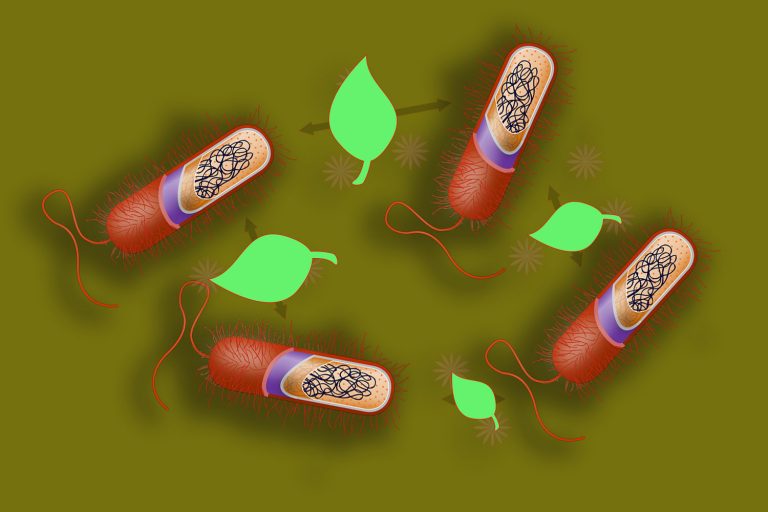18 Jan Essential oils: Mechanism of action on pathogenic bacteria

Essential oils are a promising alternative to antibiotics
Essential oils are concentrated hydrophobic liquids containing volatile aroma compounds from plants. They are usually obtained by distillation, extraction with liquid carbon dioxide or microwaving.
Essential oils contain a very complex mixture of volatile molecules that are can be classified in two main groups, according to their molecular structure:
1. Terpenes and terpenoids
Terpenes and terpenoids are hydrocarbons that are formed through the combination of several isoprene units. While most terpenes do not possess significant antimicrobial activity, many terpenoids are strong antimicrobials.
Thymol, carvacrol, linalool, menthol, geraniol, linalyl acetate, citronellal and piperitone are terpenoids commonly found in essential oils used in animal health.
2. Phenylpropanoids
Phenylpropanoids are a diverse family of molecules that are synthesized from the amino acids phenylalanine and tyrosine. Their antimicrobial activity varies from compound to compound.
Cinnamic acid, cinnamic aldehyde, eugenol, chavicol, safrole, vanillin and estragole are phenylpropanoids commonly found in essential oils used in animal health.
Many essential oils have been shown to be microbiocidal against Gram-positive and Gram-negative bacteria, yeasts and fungi. Their mechanism of action is the focus of many research efforts, as essential oils are a feasible alternative to antibiotics.
Mechanism of action at low concentrations: alteration of quorum sensing
When the number of bacteria within a population is high enough, each individual secretes and receives small signal molecules that allow the whole colony to act as a group, through the expression of certain genes. This communication system is called quorum sensing.

Thanks to quorum sensing, bacterial colonies:
- Can form biofilms.
- Become more virulent and may secrete toxins.
- Grow faster.
- Can cross the intestinal barrier and enter into bloodstream.
Since quorum sensing is responsible for pathogen virulence, finding active principles that can inhibit this communication system is a promising strategy to control pathogenic bacteria.
Many plant extracts ) Garlic, marjoram, oregano, sweet bay, rosemary, thyme, oregano, basil, tea tree, turmeric, vanilla, etc ) have been proven to disrupt bacterial quorum sensing at concentrations much lower than those needed to kill the bacteria.

Mechanism of action at high concentrations: direct effect on the bacterial cell
At high concentrations, certain essential oils can completely kill bacteria. There are several mechanisms of action:
- Toxicity on the cell wall
This is the most well-known mechanism of action.
Thanks to the hydrophobic nature of essential oils, essential oils are able to bind to the bacterial wall and act in different manners to disrupt it, increase permeability and cause the leaking of cell constituents. Ultimately this results in the death of the bacteria.

2. Action on protein synthesis
Different components of essential oils alter certain protein synthesis paths. In example, active compounds present in Cinnamon oil are capable of inhibiting cell separation in Bacillus cereus by inhibiting the synthesis of certain proteins.
3. Reduction of intracellular ATP levels
Adenosine triphosphate (ATP) is the “molecular unit of currency” of energy transfer in the cells and it is vital for cell metabolism.
Certain molecules contained in essential oils, such as eugenol, cinnamaldehyde and carvacrol, are able to inhibit the enzymes that produce ATP, disrupting bacterial metabolism.
4. Reduction of the intracellular pH
Some essential oils, such as Spanish oregano, mustard or Chinese cinnamon, significantly decrease the pH inside the bacterial cell, interfering with crucial cellular processes (DNA transcription, protein synthesis and enzymatic activity).
5. Changes in the cytoplasma
Certain essential oils (cinnamon, oregano) cause the coagulation of protein material in the cytoplasma.
Our products based in essential oils
We at PlusVet Animal Health select the best essential oils to manufacture products for respiratory health and digestive health with antimicrobial action, in order to reduce or eliminate the use of antibiotics in livestock.

Certain health statements may not be applicable in your region.

